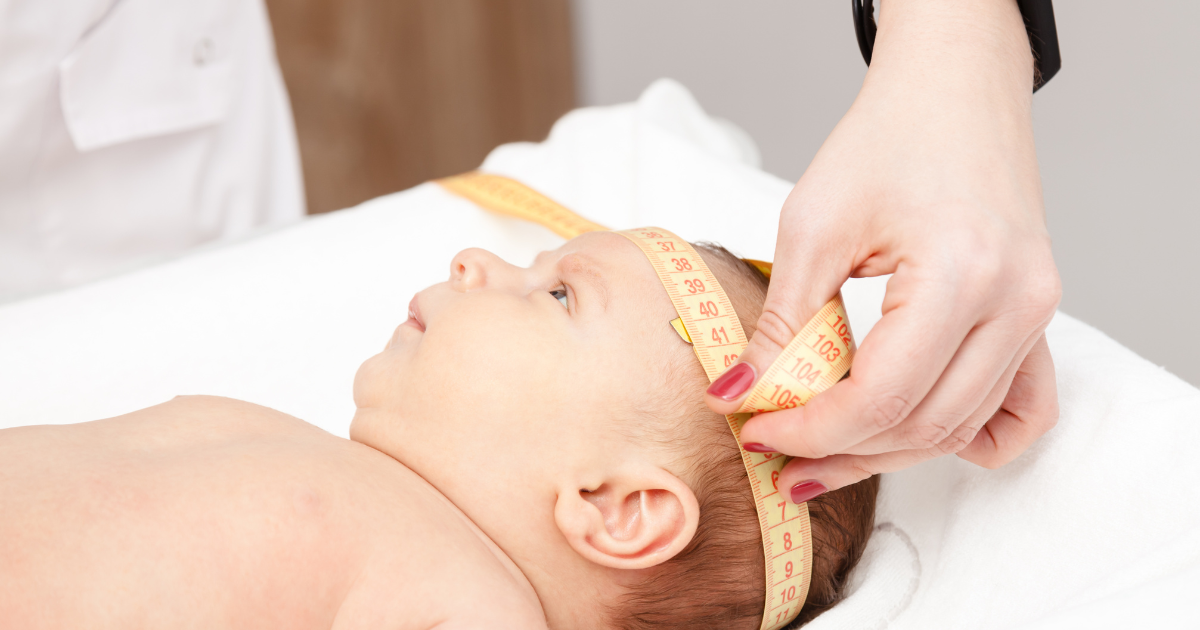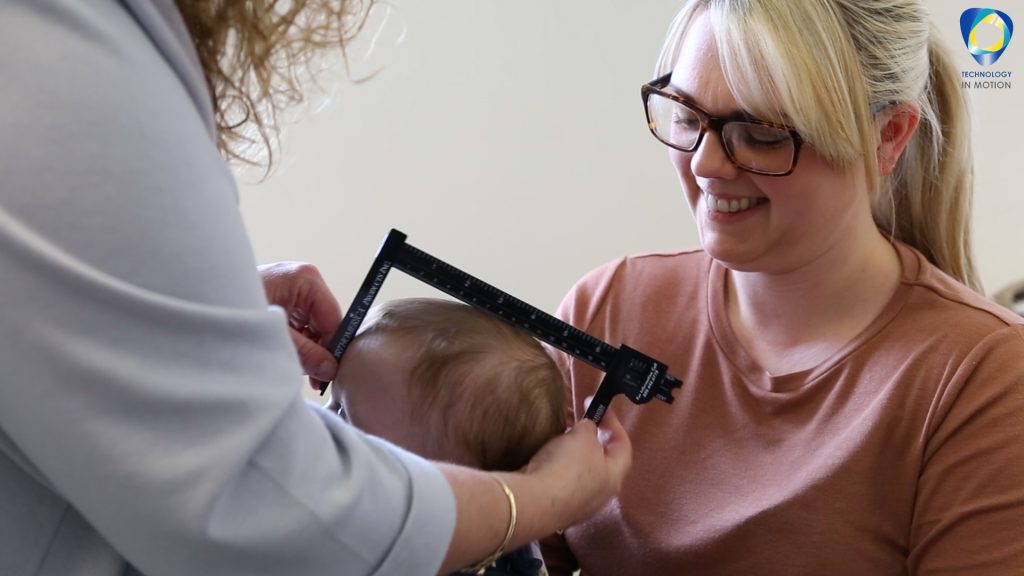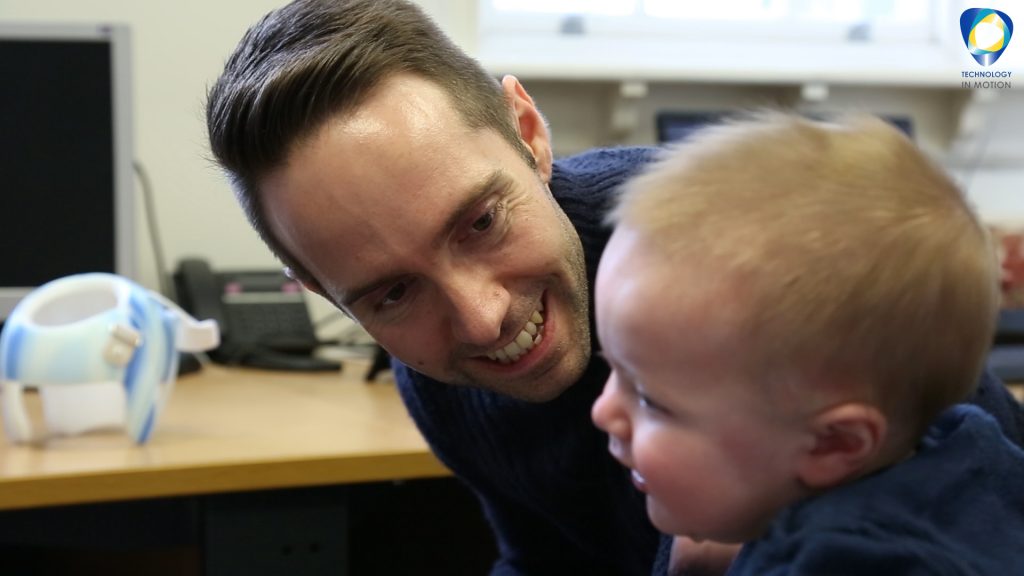
Some parents notice that their baby’s head shape can be slightly misshapen. This can be due to a variety of reasons and usually shows as plagiocephaly or brachycephaly, which are caused by prolonged pressure on one part of the head. Sometimes, a head shape deformity can be due to the less common craniosynostosis which is caused by early fusion of two or more bones in the baby’s head. The sooner parents notice and become aware of their baby’s head flattening, the quicker they can seek advice and work towards correcting it.
For infants with plagiocephaly, surgery can often be avoided by providing the appropriate treatments as the baby grows. Technology in Motion is able to provide non-surgical solutions for infants up to 14 months of age; however generally the younger the baby, the more effective the treatment.
Plagiocephaly and Brachycephaly Treatment

It can be worrying for mums and dads when they first notice that their baby has a misshapen head, but parents should feel comforted by the fact that it is extremely uncommon that a baby will need to undergo plagiocephaly surgery to resolve it. For babies less than four months of age, we recommend that parents try repositioning techniques that will help to minimise the pressure on one part of the head, naturally allowing improvement of the baby’s head shape.
In more severe cases where there can be facial or brow deformation, or there is a wide area of flattening, repositioning techniques can only give modest improvement and there is not enough natural change to correct the head shape. This is when other avenues need to be explored. In these cases, we recommend that parents book a free pre-assessment at one of our clinics. Our specialist clinicians will then advise parents on whether or not a cranial helmet is recommended to gently correct the head shape of their baby as the head grows. Even for those who haven’t yet tried repositioning or have only just started, if there is no change by four or five months of age, booking an appointment will still beneficial as a cranial helmet will bring about correction much faster than repositioning, helping babies with severe flat head syndrome.
Our non-surgical TiMBandAir plagiocephaly treatment is comfortable and designed to fit the exact shape of your baby’s head. The window of being able to treat plagiocephaly with a cranial helmet is quite short. Helmet therapy relies on a baby’s skull being flexible and growing quickly, which is the case in younger babies. However, by 18 to 24 months of age, most of the cranium growth has been achieved and the structures are becoming more rigid. So if parents want to correct the head shape after this age, the only way it can be done is with plagiocephaly surgery to correct the deformity. However, this process has all of the usual risks of surgery and is only recommended after careful consideration. With the various and safe treatment options available, plagiocephaly surgery can usually be avoided.
Craniosynostosis Treatment

Craniosynostosis is quite rare, affecting as few as 3 babies in every 10,000 births. By comparison, plagiocephaly or brachycephaly affects 3 to 4 babies in every 100. Craniosynostosis is the premature fusion of one or more of the flexible joints (sutures) between bone plates in a baby’s skull. This premature fusion restricts the baby’s skull from being able to grow properly, causing an unusual head shape. It can also result in a concerning rise of pressure of the fluid inside the skull.
Treatment of craniosynostosis differs from that of plagiocephaly and brachycephaly, and surgery is the only option to treat it. At Technology in Motion, we sometimes come across babies that we believe may be an undiagnosed case of craniosynostosis. In these circumstances, we do not offer helmet treatment and instead advise that parents take their baby to their GP for further investigation, preferably at their nearest craniofacial or neurosurgical unit. There are some cases where a cranial helmet can bring about further head shape correction post-operatively, and we work with clinicians in Europe who offer this type of intervention.
Surgery for craniosynostosis can be carried out at different ages depending on the baby’s condition and in consultation with the surgeon. The surgery procedure is designed to ensure that the child’s brain is not compressed by releasing the fused sutures, allowing the skull to grow as it should, relieving pressure on the brain.
If a flattening is noticed, it’s important for parents to get their baby’s head checked out by a specialist. Doing so will allow them to receive a diagnosis and find out the next steps to take. Surgical treatment is not a consideration for plagiocephaly and brachycephaly if it is corrected early. Craniosynostosis however, requires surgery for correction. If you are concerned about your baby’s head shape, contact us today to book a free pre-assessment with one of our clinicians and find out about the best treatment option for your little one. Our friendly team can help to diagnose your baby’s condition and advise you on the next step!


